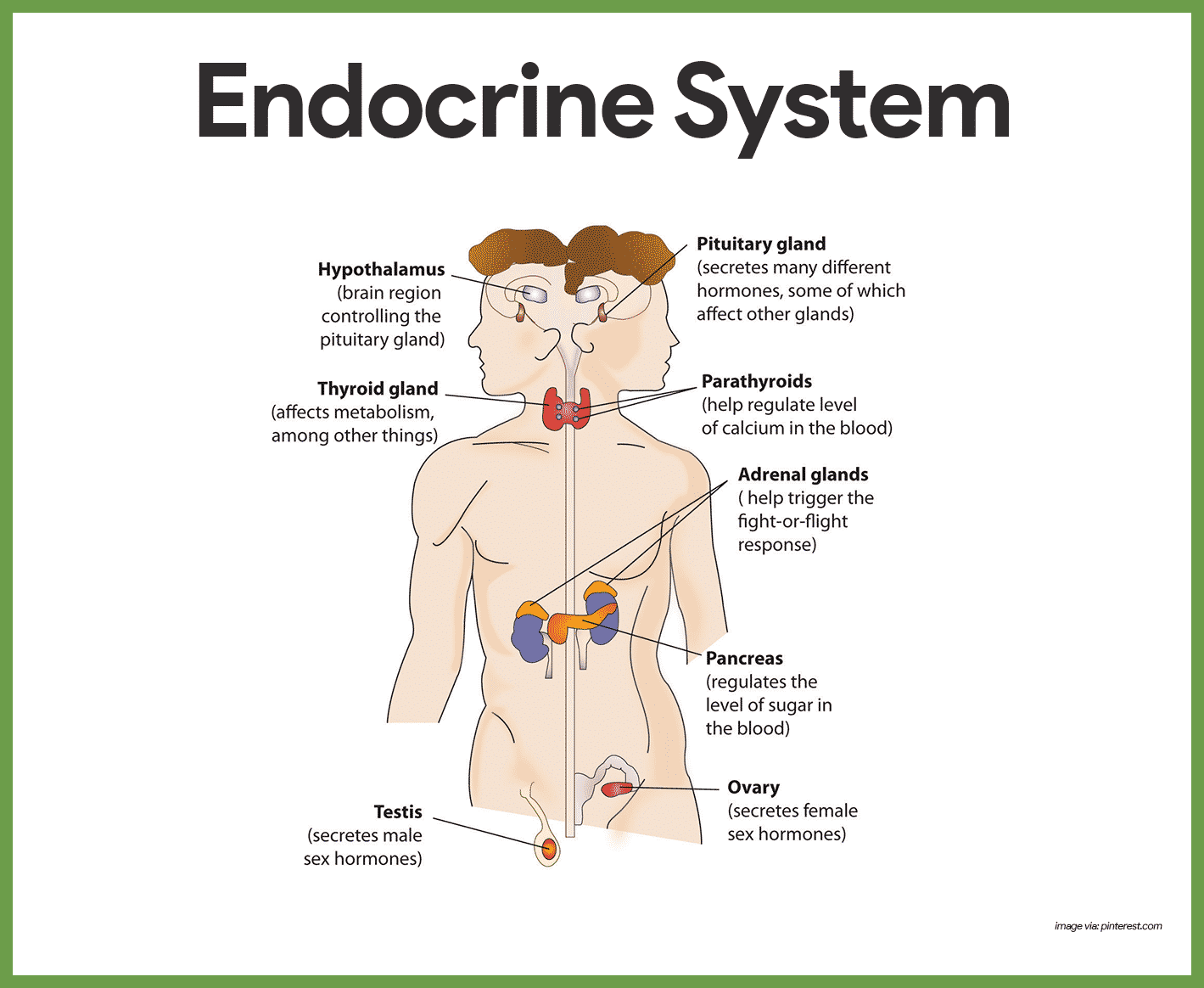Anatomy endocrine system. Anatomy of the Adrenal Glands: Unlocking the Secrets of Stress Response and Hormonal Balance
What are the main parts of the adrenal glands? How do the adrenal glands regulate key hormones like cortisol and aldosterone? What are some common adrenal gland disorders? Discover the answers to these and other questions about the anatomy and function of the adrenal glands.
Understanding the Anatomy of the Adrenal Glands
The adrenal glands are an integral part of the endocrine system, playing a crucial role in regulating the body’s response to stress and maintaining hormonal balance. These small, triangular-shaped glands sit atop the kidneys and are composed of two distinct regions:
The Adrenal Cortex
The adrenal cortex is the outer layer of the adrenal gland and is responsible for producing a variety of hormones, including cortisol, aldosterone, and dehydroepiandrosterone (DHEA). The adrenal cortex is further divided into three zones: the zona glomerulosa, zona fasciculata, and zona reticularis, each of which produces specific hormones.
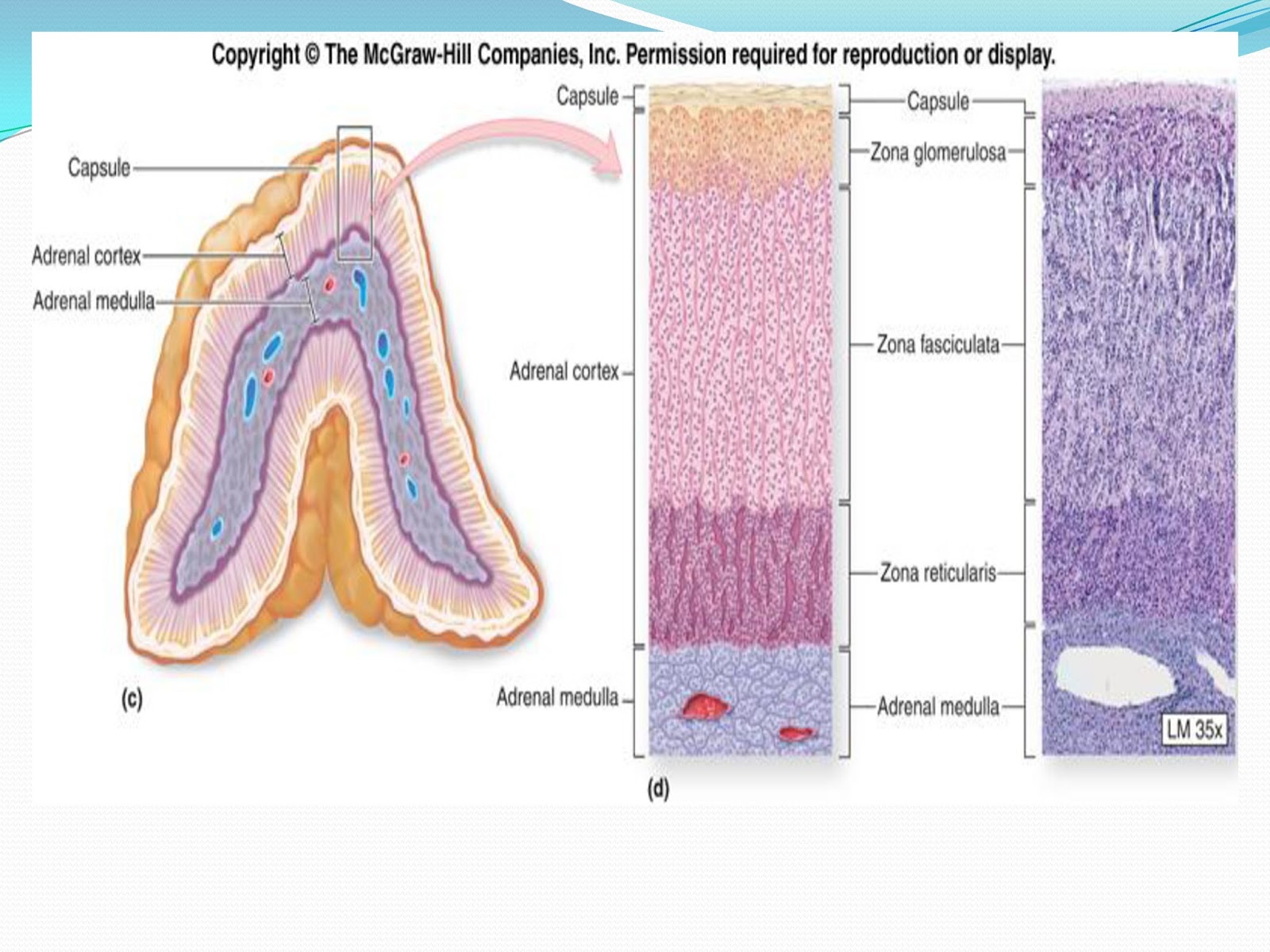
The Adrenal Medulla
The adrenal medulla is the inner core of the adrenal gland and is responsible for producing the “stress hormones” epinephrine (adrenaline) and norepinephrine (noradrenaline). These hormones play a crucial role in the body’s fight-or-flight response, helping to increase heart rate, blood pressure, and glucose metabolism in response to stressful situations.
The Adrenal Gland’s Hormonal Regulation
The adrenal glands work in concert with the hypothalamus and pituitary gland to regulate the production and release of key hormones. This complex system, known as the hypothalamic-pituitary-adrenal (HPA) axis, ensures that the body’s hormonal responses are finely tuned to meet the demands of various physiological and emotional stressors.
Cortisol Production and Regulation
How does the adrenal gland produce cortisol, the primary stress hormone? The process begins with the hypothalamus releasing corticotropin-releasing hormone (CRH), which stimulates the pituitary gland to secrete adrenocorticotropic hormone (ACTH). ACTH then signals the adrenal cortex to produce and release cortisol into the bloodstream. This negative feedback loop ensures that cortisol levels are maintained within a healthy range.

Aldosterone and Electrolyte Balance
Aldosterone, a mineralocorticoid hormone produced by the zona glomerulosa of the adrenal cortex, plays a crucial role in regulating blood pressure and electrolyte balance. Aldosterone signals the kidneys to reabsorb sodium and excrete potassium, helping to maintain healthy levels of these essential electrolytes in the blood.
Common Adrenal Gland Disorders
Imbalances in the production of adrenal hormones can lead to a range of health issues. Two of the most common adrenal gland disorders are:
Adrenal Insufficiency
Adrenal insufficiency is a rare condition in which the adrenal glands produce insufficient amounts of cortisol and/or aldosterone. This can be caused by diseases affecting the adrenal glands or the pituitary gland, which regulates adrenal function.
Cushing’s Syndrome
Cushing’s syndrome is a condition characterized by excessive production of cortisol, often caused by a tumor in the pituitary gland or the adrenal glands themselves. This hormonal imbalance can lead to weight gain, high blood pressure, and other health problems.

The Importance of Adrenal Gland Health
The adrenal glands play a vital role in the body’s stress response and overall hormonal balance. Understanding the anatomy and function of these glands is crucial for maintaining optimal health and identifying and treating any potential adrenal gland disorders. By working closely with healthcare professionals, individuals can ensure their adrenal glands are functioning properly and take steps to support their overall endocrine system health.
Frequently Asked Questions
What are the main hormones produced by the adrenal glands?
The main hormones produced by the adrenal glands include cortisol, aldosterone, DHEA, epinephrine, and norepinephrine. Cortisol and aldosterone are produced by the adrenal cortex, while epinephrine and norepinephrine are produced by the adrenal medulla.
How do the adrenal glands regulate cortisol production?
The adrenal glands regulate cortisol production through a negative feedback loop involving the hypothalamus, pituitary gland, and adrenal glands. The hypothalamus releases corticotropin-releasing hormone (CRH), which stimulates the pituitary gland to secrete adrenocorticotropic hormone (ACTH). ACTH then signals the adrenal cortex to produce and release cortisol, which in turn signals the hypothalamus and pituitary gland to reduce CRH and ACTH production, respectively.

What are the common adrenal gland disorders?
The two most common adrenal gland disorders are adrenal insufficiency, where the adrenal glands produce insufficient amounts of cortisol and/or aldosterone, and Cushing’s syndrome, where the adrenal glands produce excessive amounts of cortisol.
Conclusion
The adrenal glands are essential endocrine organs that play a crucial role in regulating the body’s stress response, maintaining hormonal balance, and supporting overall health. By understanding the anatomy and function of the adrenal glands, as well as the common disorders that can affect them, individuals can take proactive steps to support their adrenal health and address any potential imbalances or issues that may arise.
Adrenal Glands | Johns Hopkins Medicine
Anatomy of the Adrenal Glands
An adrenal gland is made of two main parts:
The adrenal cortex is the outer region and also the largest part of an adrenal gland. It is divided into three separate zones: zona glomerulosa, zona fasciculata and zona reticularis. Each zone is responsible for producing specific hormones.
The adrenal medulla is located inside the adrenal cortex in the center of an adrenal gland. It produces “stress hormones,” including adrenaline.
The adrenal cortex and adrenal medulla are enveloped in an adipose capsule that forms a protective layer around an adrenal gland.
Hormones of the Adrenal Glands
The role of the adrenal glands in your body is to release certain hormones directly into the bloodstream. Many of these hormones have to do with how the body responds to stress, and some are vital to existence. Both parts of the adrenal glands — the adrenal cortex and the adrenal medulla — perform distinct and separate functions.
Both parts of the adrenal glands — the adrenal cortex and the adrenal medulla — perform distinct and separate functions.
Each zone of the adrenal cortex secretes a specific hormone. The key hormones produced by the adrenal cortex include:
Cortisol
Cortisol is a glucocorticoid hormone produced by the zona fasciculata that plays several important roles in the body. It helps control the body’s use of fats, proteins and carbohydrates; suppresses inflammation; regulates blood pressure; increases blood sugar; and can also decrease bone formation.
This hormone also controls the sleep/wake cycle. It is released during times of stress to help your body get an energy boost and better handle an emergency situation.
How Adrenal Glands Work to Produce Cortisol
Adrenal glands produce hormones in response to signals from the pituitary gland in the brain, which reacts to signaling from the hypothalamus, also located in the brain. This is referred to as the hypothalamic pituitary adrenal axis.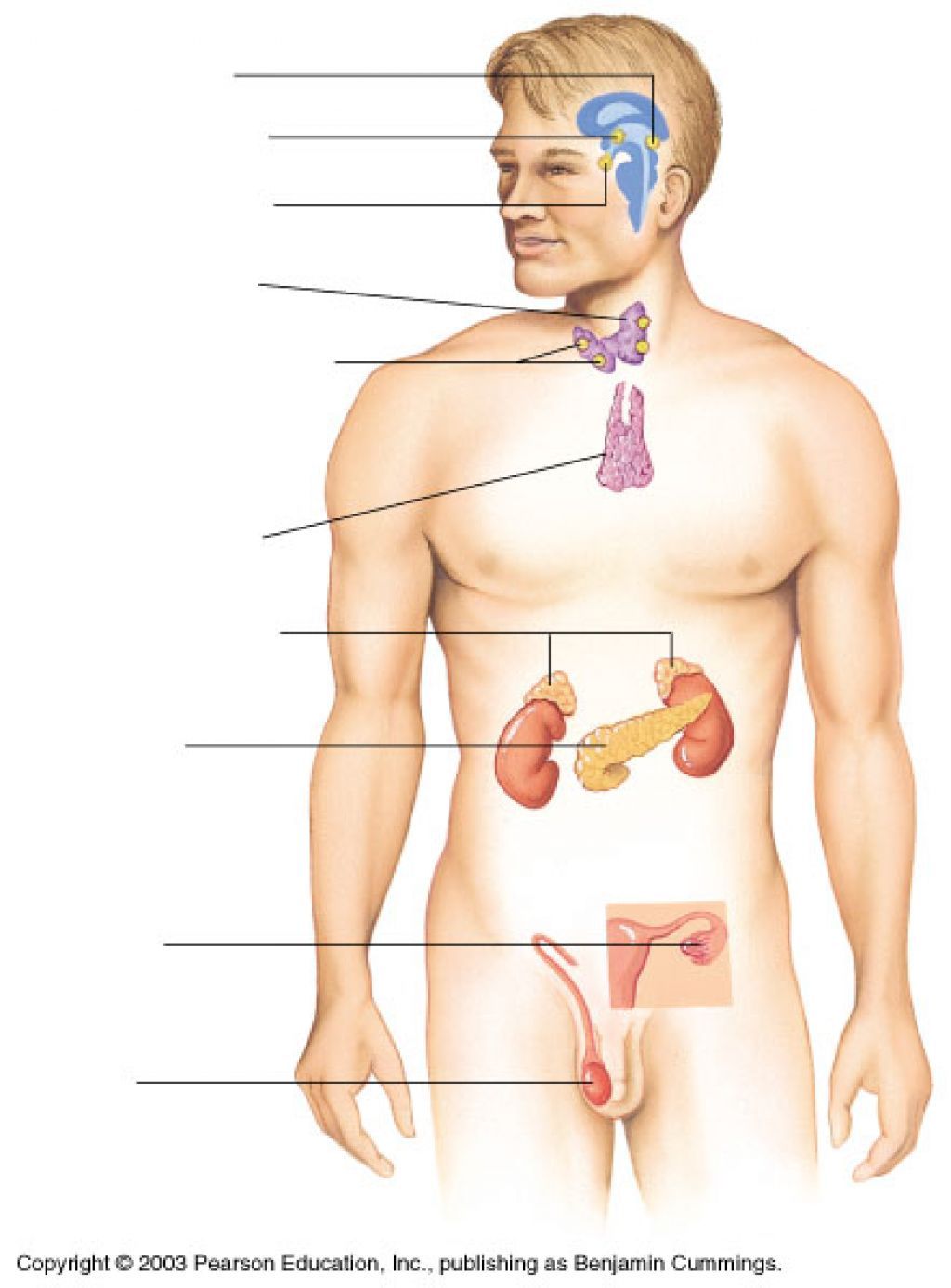 As an example, for the adrenal gland to produce cortisol, the following occurs:
As an example, for the adrenal gland to produce cortisol, the following occurs:
The hypothalamus produces corticotropin-releasing hormone (CRH) that stimulates the pituitary gland to secrete adrenocorticotropin hormone (ACTH).
ACTH then stimulates the adrenal glands to make and release cortisol hormones into the blood.
Normally, both the hypothalamus and the pituitary gland can sense whether the blood has the appropriate amount of cortisol circulating. If there is too much or too little cortisol, these glands respectively change the amount of CRH and ACTH that gets released. This is referred to as a negative feedback loop.
Excess cortisol production can occur from nodules in the adrenal gland or excess production of ACTH from a tumor in the pituitary gland or other source.
Aldosterone
This mineralocorticoid hormone produced by the zona glomerulosa plays a central role in regulating blood pressure and certain electrolytes (sodium and potassium). Aldosterone sends signals to the kidneys, resulting in the kidneys absorbing more sodium into the bloodstream and releasing potassium into the urine. This means that aldosterone also helps regulate the blood pH by controlling the levels of electrolytes in the blood.
Aldosterone sends signals to the kidneys, resulting in the kidneys absorbing more sodium into the bloodstream and releasing potassium into the urine. This means that aldosterone also helps regulate the blood pH by controlling the levels of electrolytes in the blood.
DHEA and Androgenic Steroids
These hormones produced by the zona reticularis are weak male hormones. They are precursor hormones that are converted in the ovaries into female hormones (estrogens) and in the testes into male hormones (androgens). However, estrogens and androgens are produced in much larger amounts by the ovaries and testes.
Epinephrine (Adrenaline) and Norepinephrine (Noradrenaline)
The adrenal medulla, the inner part of an adrenal gland, controls hormones that initiate the flight or fight response. The main hormones secreted by the adrenal medulla include epinephrine (adrenaline) and norepinephrine (noradrenaline), which have similar functions.
Among other things, these hormones are capable of increasing the heart rate and force of heart contractions, increasing blood flow to the muscles and brain, relaxing airway smooth muscles, and assisting in glucose (sugar) metabolism. They also control the squeezing of the blood vessels (vasoconstriction), helping maintain blood pressure and increasing it in response to stress.
They also control the squeezing of the blood vessels (vasoconstriction), helping maintain blood pressure and increasing it in response to stress.
Like several other hormones produced by the adrenal glands, epinephrine and norepinephrine are often activated in physically and emotionally stressful situations when your body needs additional resources and energy to endure unusual strain.
Adrenal Gland Disorders
The two common ways in which adrenal glands cause health issues are by producing too little or too much of certain hormones, which leads to hormonal imbalances. These abnormalities of the adrenal function can be caused by various diseases of the adrenal glands or the pituitary gland.
Adrenal Insufficiency
Adrenal insufficiency is a rare disorder. It may be caused by disease of the adrenal glands (primary adrenal insufficiency, Addison’s disease) or by diseases in the hypothalamus or the pituitary (secondary adrenal insufficiency). It is the opposite of Cushing syndrome and is characterized by low levels of adrenal hormones. The symptoms include weight loss, poor appetite, nausea and vomiting, fatigue, darkening of skin (only in primary adrenal insufficiency), abdominal pain, among other.
The symptoms include weight loss, poor appetite, nausea and vomiting, fatigue, darkening of skin (only in primary adrenal insufficiency), abdominal pain, among other.
The causes of primary adrenal insufficiency may include autoimmune disorders, fungal and other infections, cancer (rarely), and genetic factors.
Although adrenal insufficiency usually develops over time, it can also appear suddenly as an acute adrenal failure (adrenal crisis). It has similar symptoms, but the consequences are more serious, including life-threatening shock, seizures, and coma. These may develop if the condition is left untreated.
Congenital Adrenal Hyperplasia
Adrenal insufficiency can also result from a genetic disorder called congenital adrenal hyperplasia. Children who are born with this disorder are missing an essential enzyme necessary to produce cortisol, aldosterone or both. At the same time, they often experience excess of androgen, which may lead to male characteristics in girls and precocious puberty in boys.
Congenital adrenal hyperplasia can remain undiagnosed for years depending on the severity of the enzyme deficiency. In more severe cases, infants may suffer from ambiguous genitalia, dehydration, vomiting and failure to thrive.
Overactive Adrenal Glands
Sometimes, adrenal glands may develop nodules that produce too much of certain hormones. Nodules 4 centimeters or larger and nodules that show certain features on imaging increase suspicion for malignancy. Both benign and cancerous nodules may produce excessive amounts of certain hormones, which is referred to as a functional nodule. Functional tumors, malignant tumors or nodules greater than 4 centimeters are recommended to be referred for surgical evaluation.
Excess of Cortisol: Cushing Syndrome
Cushing syndrome results from excessive production of cortisol from the adrenal glands. The symptoms may include weight gain and fatty deposits in certain areas of the body, such as the face, below the back of the neck called a buffalo hump and in the abdomen; thinning arms and legs; purple stretch marks on the abdomen; facial hair; fatigue; muscle weakness; easily bruised skin; high blood pressure; diabetes; and other health issues.
Excess cortisol production can also be triggered by overproduction of ACTH by a benign tumor in the pituitary gland or tumor elsewhere in the body. This is known as Cushing Disease. Another common cause of Cushing syndrome is excessive and prolonged consumption of external steroids, such as prednisone or dexamethasone, which are prescribed to treat many autoimmune or inflammatory diseases (e.g., lupus, rheumatoid arthritis, asthma, inflammatory bowel disease, multiple sclerosis, etc.)
Excess of Aldosterone: Hyperaldosteronism
Hyperaldosteronism results from overproduction of aldosterone from one or both adrenal glands. This is characterized by increase in blood pressure that often requires many medications to control. Some people can develop low potassium levels in the blood, which can cause muscle aches, weakness and spasms. When the cause is adrenal oversecretion, the disease is called Conn syndrome.
Excess of Adrenaline or Noradrenaline: Pheochromocytoma
Pheochromocytoma is a tumor that results in excess production of adrenaline or noradrenaline by the adrenal medulla that often happens in bursts. Occasionally, neural crest tissue, which has similar tissue to the adrenal medulla, may be the cause of overproduction of these hormones. This known as a paraganglioma.
Occasionally, neural crest tissue, which has similar tissue to the adrenal medulla, may be the cause of overproduction of these hormones. This known as a paraganglioma.
Pheochromocytomas may cause persistent or sporadic high blood pressure that may be difficult to control with regular medications. Other symptoms include headaches, sweating, tremors, anxiety and rapid heartbeat. Some people are genetically predisposed to developing this type of tumor.
Adrenal Cancer
Malignant adrenal tumors (adrenal cancer), such as adrenocortical carcinoma, are rare and often have spread to other organs and tissues by the time they are diagnosed. These tumors tend to grow fairly large and can reach several inches in diameter.
Cancerous adrenal tumors can be functional and release excess of one or more hormones accompanied by corresponding symptoms, as listed above. Patients may also experience abdominal pain, flank pain or a feeling of abdominal fullness, especially when the adrenal tumor gets very large.
Not all cancers found in adrenal glands originate from the gland itself. The majority of adrenal tumors are metastasis, or cancer spread, from another primary tumor elsewhere in the body.
17.1 An Overview of the Endocrine System – Anatomy and Physiology 2e
Learning Objectives
By the end of this section, you will be able to:
- Distinguish the types of intercellular communication, their importance, mechanisms, and effects
- Identify the major organs and tissues of the endocrine system and their location in the body
Communication is a process in which a sender transmits signals to one or more receivers to control and coordinate actions. In the human body, two major organ systems participate in relatively “long distance” communication: the nervous system and the endocrine system. Together, these two systems are primarily responsible for maintaining homeostasis in the body.
Neural and Endocrine Signaling
The nervous system uses two types of intercellular communication—electrical and chemical signaling—either by the direct action of an electrical potential, or in the latter case, through the action of chemical neurotransmitters such as serotonin or norepinephrine. Neurotransmitters act locally and rapidly. When an electrical signal in the form of an action potential arrives at the synaptic terminal, they diffuse across the synaptic cleft (the gap between a sending neuron and a receiving neuron or muscle cell). Once the neurotransmitters interact (bind) with receptors on the receiving (post-synaptic) cell, the receptor stimulation is transduced into a response such as continued electrical signaling or modification of cellular response. The target cell responds within milliseconds of receiving the chemical “message”; this response then ceases very quickly once the neural signaling ends. In this way, neural communication enables body functions that involve quick, brief actions, such as movement, sensation, and cognition.In contrast, the endocrine system uses just one method of communication: chemical signaling. These signals are sent by the endocrine organs, which secrete chemicals—the hormone—into the extracellular fluid. Hormones are transported primarily via the bloodstream throughout the body, where they bind to receptors on target cells, inducing a characteristic response.
Neurotransmitters act locally and rapidly. When an electrical signal in the form of an action potential arrives at the synaptic terminal, they diffuse across the synaptic cleft (the gap between a sending neuron and a receiving neuron or muscle cell). Once the neurotransmitters interact (bind) with receptors on the receiving (post-synaptic) cell, the receptor stimulation is transduced into a response such as continued electrical signaling or modification of cellular response. The target cell responds within milliseconds of receiving the chemical “message”; this response then ceases very quickly once the neural signaling ends. In this way, neural communication enables body functions that involve quick, brief actions, such as movement, sensation, and cognition.In contrast, the endocrine system uses just one method of communication: chemical signaling. These signals are sent by the endocrine organs, which secrete chemicals—the hormone—into the extracellular fluid. Hormones are transported primarily via the bloodstream throughout the body, where they bind to receptors on target cells, inducing a characteristic response. As a result, endocrine signaling requires more time than neural signaling to prompt a response in target cells, though the precise amount of time varies with different hormones. For example, the hormones released when you are confronted with a dangerous or frightening situation, called the fight-or-flight response, occur by the release of adrenal hormones—epinephrine and norepinephrine—within seconds. In contrast, it may take up to 48 hours for target cells to respond to certain reproductive hormones.
As a result, endocrine signaling requires more time than neural signaling to prompt a response in target cells, though the precise amount of time varies with different hormones. For example, the hormones released when you are confronted with a dangerous or frightening situation, called the fight-or-flight response, occur by the release of adrenal hormones—epinephrine and norepinephrine—within seconds. In contrast, it may take up to 48 hours for target cells to respond to certain reproductive hormones.
Interactive Link
Visit this link to watch an animation of the events that occur when a hormone binds to a cell membrane receptor. What is the secondary messenger made by adenylyl cyclase during the activation of liver cells by epinephrine?
In addition, endocrine signaling is typically less specific than neural signaling. The same hormone may play a role in a variety of different physiological processes depending on the target cells involved. For example, the hormone oxytocin promotes uterine contractions in people in labor. It is also important in breastfeeding, and may be involved in the sexual response and in feelings of emotional attachment in humans.
It is also important in breastfeeding, and may be involved in the sexual response and in feelings of emotional attachment in humans.
In general, the nervous system involves quick responses to rapid changes in the external environment, and the endocrine system is usually slower acting—taking care of the internal environment of the body, maintaining homeostasis, and controlling reproduction (Table 17.1). So how does the fight-or-flight response that was mentioned earlier happen so quickly if hormones are usually slower acting? It is because the two systems are connected. It is the fast action of the nervous system in response to the danger in the environment that stimulates the adrenal glands to secrete their hormones. As a result, the nervous system can cause rapid endocrine responses to keep up with sudden changes in both the external and internal environments when necessary.
Endocrine and Nervous Systems
| Endocrine system | Nervous system | |
|---|---|---|
| Signaling mechanism(s) | Chemical | Chemical/electrical |
| Primary chemical signal | Hormones | Neurotransmitters |
| Distance traveled | Long or short | Always short |
| Response time | Fast or slow | Always fast |
| Environment targeted | Internal | Internal and external |
Table
17. 1
1
Structures of the Endocrine System
The endocrine system consists of cells, tissues, and organs that secrete hormones as a primary or secondary function. The endocrine gland is the major player in this system. The primary function of these ductless glands is to secrete their hormones directly into the surrounding fluid. The interstitial fluid and the blood vessels then transport the hormones throughout the body. The endocrine system includes the pituitary, thyroid, parathyroid, adrenal, and pineal glands (Figure 17.2). Some of these glands have both endocrine and non-endocrine functions. For example, the pancreas contains cells that function in digestion as well as cells that secrete the hormones insulin and glucagon, which regulate blood glucose levels. The hypothalamus, thymus, heart, kidneys, stomach, small intestine, liver, skin, ovaries, and testes are other organs that contain cells with endocrine function. Moreover, adipose tissue has long been known to produce hormones, and recent research has revealed that even bone tissue has endocrine functions.
Figure
17.2
Endocrine System
Endocrine glands and cells are located throughout the body and play an important role in homeostasis.
The ductless endocrine glands are not to be confused with the body’s exocrine system, whose glands release their secretions through ducts. Examples of exocrine glands include the sebaceous and sweat glands of the skin. As just noted, the pancreas also has an exocrine function: most of its cells secrete pancreatic juice through the pancreatic and accessory ducts to the lumen of the small intestine.
Other Types of Chemical Signaling
In endocrine signaling, hormones secreted into the extracellular fluid diffuse into the blood or lymph, and can then travel great distances throughout the body. In contrast, autocrine signaling takes place within the same cell. An autocrine (auto- = “self”) is a chemical that elicits a response in the same cell that secreted it. Interleukin-1, or IL-1, is a signaling molecule that plays an important role in inflammatory response. The cells that secrete IL-1 have receptors on their cell surface that bind these molecules, resulting in autocrine signaling.
The cells that secrete IL-1 have receptors on their cell surface that bind these molecules, resulting in autocrine signaling.
Local intercellular communication is the province of the paracrine, also called a paracrine factor, which is a chemical that induces a response in neighboring cells. Although paracrines may enter the bloodstream, their concentration is generally too low to elicit a response from distant tissues. A familiar example to those with asthma is histamine, a paracrine that is released by immune cells in the bronchial tree. Histamine causes the smooth muscle cells of the bronchi to constrict, narrowing the airways. Another example is the neurotransmitters of the nervous system, which act only locally within the synaptic cleft.
Career Connection
Endocrinologist
Endocrinology is a specialty in the field of medicine that focuses on the treatment of endocrine system disorders. Endocrinologists—medical doctors who specialize in this field—are experts in treating diseases associated with hormonal systems, ranging from thyroid disease to diabetes mellitus.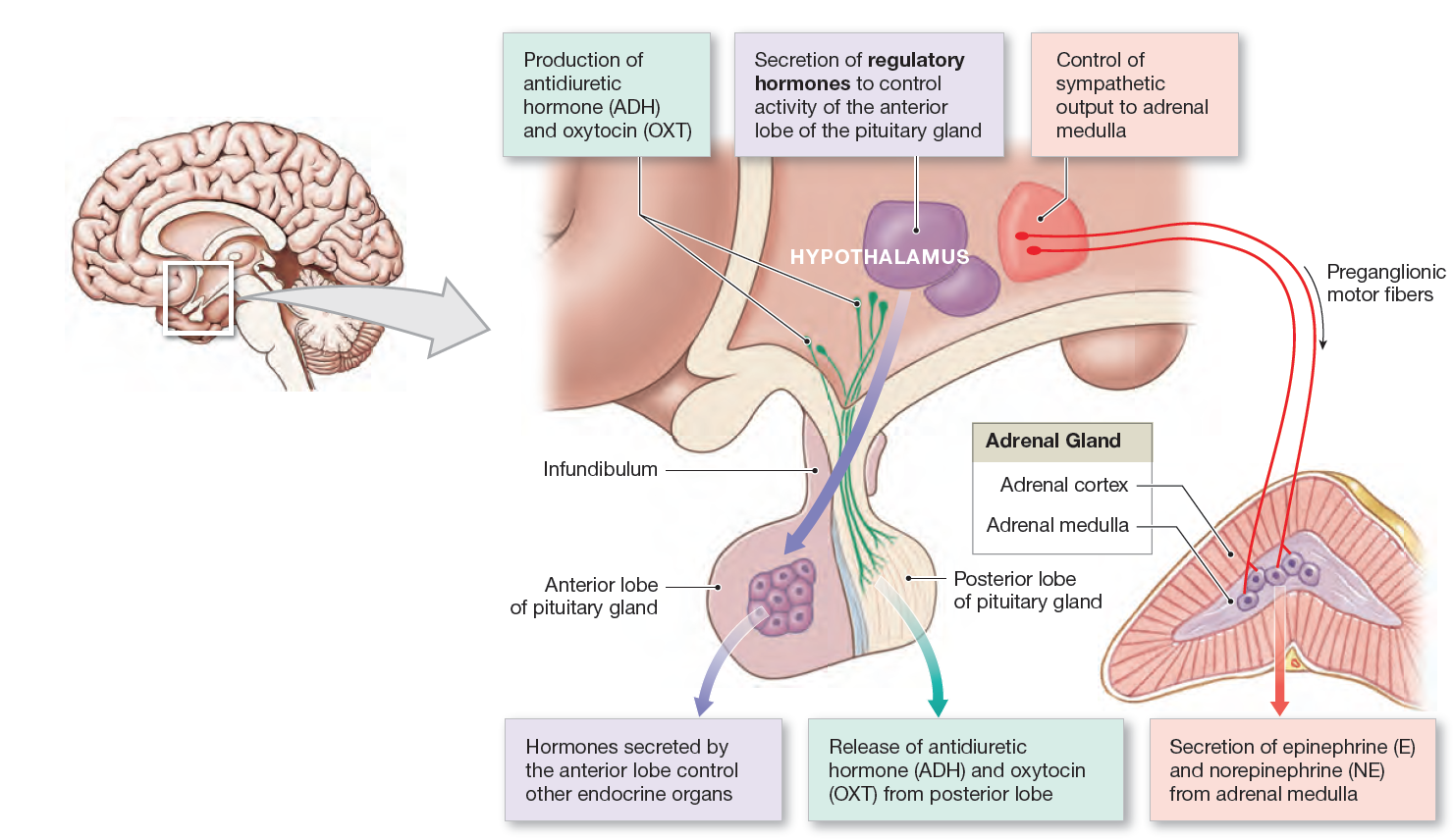 Endocrine surgeons treat endocrine disease through the removal, or resection, of the affected endocrine gland.
Endocrine surgeons treat endocrine disease through the removal, or resection, of the affected endocrine gland.
Patients who are referred to endocrinologists may have signs and symptoms or blood test results that suggest excessive or impaired functioning of an endocrine gland or endocrine cells. The endocrinologist may order additional blood tests to determine whether the patient’s hormonal levels are abnormal, or they may stimulate or suppress the function of the suspect endocrine gland and then have blood taken for analysis. Treatment varies according to the diagnosis. Some endocrine disorders, such as type 2 diabetes, may respond to lifestyle changes such as modest weight loss, adoption of a healthy diet, and regular physical activity. Other disorders may require medication, such as hormone replacement, and routine monitoring by the endocrinologist. These include disorders of the pituitary gland that can affect growth and disorders of the thyroid gland that can result in a variety of metabolic problems.
Some patients experience health problems as a result of the normal decline in hormones that can accompany aging. These patients can consult with an endocrinologist to weigh the risks and benefits of hormone replacement therapy intended to boost their natural levels of reproductive hormones.
In addition to treating patients, endocrinologists may be involved in research to improve the understanding of endocrine system disorders and develop new treatments for these diseases.
Anatomy: endocrine system | USE in biology
Endocrine system
Humoral regulation is the coordination of physiological functions with the help of biologically active substances through body fluids – blood, lymph and tissue fluid.
Biologically active substances are substances produced by cells and tissues of the body and have a strong stimulating effect on body functions. These include hormones, vitamins and other substances. Most vitamins enter the human body from the outside, while hormones and other substances are produced by special glands.
The glands of the human body are divided into glands of external, internal and mixed secretion. external secretion glands include all glands that have ducts and periodically discharge their products into the organ cavity or out. These are salivary, lacrimal, sweat, sebaceous and other glands. They produce digestive enzymes, tear fluid, sebum, etc. Endocrine glands produce hormones that enter the internal environment of the body. Glands of mixed secretion excrete their products both into the blood and into the organs of the body.
Hormones are biologically active substances produced by the glands of internal and mixed secretion and acting in target tissues in microscopic quantities.
However, the effect of hormones does not extend to the entire body, but only to specific cells, tissues and organs. This property is called specificity. The lack of hormones associated with the hypofunction of the corresponding gland, as well as the excess due to its hyperfunction, negatively affect the vital activity of the body, leading to the appearance of pathological changes.
The totality of glands of internal and mixed secretion is called the endocrine system of the organism . The structure and functions of the endocrine glands are studied by science endocrinology .
The endocrine system of the human body is formed by the hypothalamus, pituitary gland, pineal gland, thyroid gland, parathyroid glands, pancreas, adrenal glands and sex glands (ovaries and testicles).
Hypothalamus — part of the diencephalon, the highest center of neurohumoral regulation in the human body. It produces substances that affect the formation of pituitary hormones, as well as two hormones only released by the pituitary gland – vasopressin (antidiuretic hormone) and oxytocin. Vasopressin retains water in the body during urination. A decrease in the concentration of this hormone leads to rapid loss of water and even dehydration. Oxytocin stimulates labor activity, causing the fetus to be expelled from the uterus.
The pituitary gland is a small gland located at the base of the brain that produces a number of hormones, as well as releases vasopressin and oxytocin produced by the hypothalamus. Pituitary hormones stimulate the activity of other endocrine glands. These include adrenocorticotropic hormone (ACTH), gonadotropic hormones – luteinizing (LH) and follicle-stimulating (FSH), lactotropic hormone, or prolactin (LTH), melanocyte-stimulating hormone (MSH), growth hormone (STH) and thyroid-stimulating hormone (TSH).
Pituitary hormones stimulate the activity of other endocrine glands. These include adrenocorticotropic hormone (ACTH), gonadotropic hormones – luteinizing (LH) and follicle-stimulating (FSH), lactotropic hormone, or prolactin (LTH), melanocyte-stimulating hormone (MSH), growth hormone (STH) and thyroid-stimulating hormone (TSH).
ACTH regulates the activity of the adrenal glands and stimulates the release of their hormones. Gonadotropic hormones contribute to the formation of the gonads and their normal functioning. LTH causes mammary glands to enlarge and produce milk in the mother after the baby is born. MSH enhances human skin pigmentation. STG stimulates the growth of the body. Lack of STH leads to dwarfism , while body proportions and mental development remain normal. Excess GH causes gigantism , and if the concentration of the hormone increases in an adult, then the size of individual protruding organs increases – this disease is called acromegaly .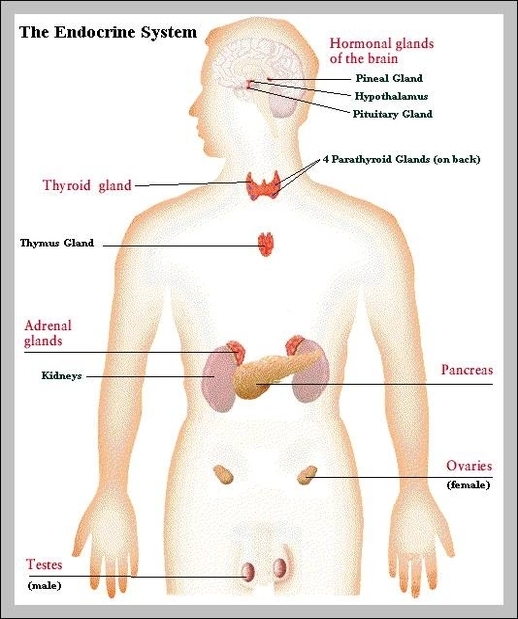 TSH controls the activity of the thyroid gland.
TSH controls the activity of the thyroid gland.
Pineal gland , or pineal gland , which is part of the diencephalon, is involved in the regulation of biological rhythms of the body and produces the hormone melatonin, which causes skin lightening.
Thyroid , located in the middle region of the neck, secretes the thyroid hormones thyroxine and triiodothyronine, as well as calcitonin. Thyroid hormones regulate metabolism in the body, contributing to the normal processes of growth, development and differentiation of tissues. Calcitonin lowers the level of calcium in the blood by depositing it in the bones.
Hyperfunction of the thyroid gland leads to an increase in the intensity of metabolism, excitability of the nervous system, insomnia and the development of goiter. The complex of these symptoms is called Graves’ disease . Hypofunction of the thyroid gland, on the contrary, causes a slowdown in the metabolism that accumulates in the skin, and increases the excitability of the nervous system. This disease is called myxedema . Lack of thyroid hormones during childhood and adolescence leads to dwarfism and cretinism.
This disease is called myxedema . Lack of thyroid hormones during childhood and adolescence leads to dwarfism and cretinism.
Parathyroid glands are located on the surface of the thyroid gland and secrete parathormone. It increases the level of calcium in the blood and therefore is an antagonist of calcitonin. Hyperfunction of the parathyroid glands can lead to bone disorders and osteoporosis.
Adrenal glands are paired endocrine organs located near the top of the kidneys. In the adrenal glands, the cortical layer and the medulla are isolated. Corticosteroids are formed in the cortical layer of the adrenal glands, and adrenaline and noradrenaline are formed in the medulla. Corticosteroids regulate the metabolism of organic and inorganic substances in the human body. Their deficiency leads to Addison’s (bronze) disease , the symptoms of which are increased skin pigmentation, weakness, dizziness, arterial hypotension, vague pain in the intestines and diarrhea.
Adrenaline is secreted by the adrenal glands in many critical situations. It enhances the work of the heart, constricts blood vessels, inhibits digestion, increases oxygen consumption, increases the concentration of glucose in the blood, blood flow in the liver, etc. The release of adrenaline into the blood is associated with the action of strong irritants on the human body and is an integral component of the body’s stress reactions.
Glands of mixed secretion include pancreas and gonads.
The pancreas , in addition to digestive enzymes, releases into the bloodstream the hormones insulin and glucagon, which regulate carbohydrate metabolism. Insulin reduces the concentration of glucose in the blood, facilitating its binding in the liver and other organs, and glucagon , on the contrary, increases the concentration of glucose in the blood due to the breakdown of glycogen in the liver. Lack of insulin, leading to an increase in the concentration of glucose in the blood, causes the development of diabetes mellitus . Excess insulin can lead to a sharp drop in glucose concentration, loss of consciousness and convulsions. Deviations in the content of glucagon in humans are extremely rare.
Excess insulin can lead to a sharp drop in glucose concentration, loss of consciousness and convulsions. Deviations in the content of glucagon in humans are extremely rare.
Sex glands simultaneously produce sex products and sex hormones (female – estrogens , male – androgens ), exerting a significant influence on the processes of growth, development and puberty, as well as regulating the formation of secondary sexual characteristics.
Neurohumoral regulation of the vital processes of the body as the basis of its integrity,
connections with the environment
The nervous and endocrine systems are an inseparable unity due to numerous direct and feedback connections. Receiving signals from various receptors is the prerogative of the nervous system, which is included in the work of the first. Its impulses instantly and accurately affect the organs, changing their activity. However, the control from the nervous system is short-lived, it acts pointwise, while in order to “fix” the effect and involve the whole organism in the reaction, the signal through the hypothalamus also goes to the endocrine system. The hypothalamus itself secretes the hormones vasopressin and oxytocin, which have a significant effect on body functions. The hypothalamus also secretes peptides that regulate the functioning of the pituitary gland, which, in turn, acts on other endocrine glands with the help of its own hormones. Hormones secreted by the endocrine glands, on the one hand, act for a longer time, and on the other hand, they connect other organs to work, and also coordinate their activities.
The hypothalamus itself secretes the hormones vasopressin and oxytocin, which have a significant effect on body functions. The hypothalamus also secretes peptides that regulate the functioning of the pituitary gland, which, in turn, acts on other endocrine glands with the help of its own hormones. Hormones secreted by the endocrine glands, on the one hand, act for a longer time, and on the other hand, they connect other organs to work, and also coordinate their activities.
The hormones of the endocrine glands are also necessary for the normal development of the nervous system itself, since, for example, when there is a shortage of thyroid hormones in childhood, underdevelopment of the brain occurs, leading to cretinism.
Anatomy
Topic: Morphofunctional characteristics of the organs of the endocrine apparatus,
topography and role in the regulation of the activity of organs and systems of the body.
Plan :
- General characteristics of the endocrine glands
- Topography
- Regulation of the activity of organs and systems of the body.

Endocrine glands (glandulae endocrinae, from Greek endo – inside, krino
– I allocate), or endocrine glands, are called glands, the main
whose functions are the formation and release into the blood of special active
chemicals – hormones. Hormones have a regulating effect on
functions of the whole organism and individual organs, mainly on different sides
metabolism.
The endocrine glands include the pituitary gland, pineal gland, thyroid gland, parathyroid
the prominent glands, the thymus gland, the endocrine part (islands) of the pancreas
glands, adrenal glands, endocrine part of the gonads (ovaries in women, testicles in
men). Endocrine function is inherent in many other organs (different departments
alimentary canal, kidney, etc. ), but in them it is not the main one.
), but in them it is not the main one.
Endocrine glands are formed from rudiments arising from different germ layers.
From the ectoderm, the rudiments of the pituitary gland, pineal gland and medulla develop.
adrenal glands, from the endoderm – the thyroid gland, parathyroid glands,
thymus gland and the endocrine part of the pancreas, from the mesoderm –
rudiments of the cortical substance of the adrenal glands and gonads.
Endocrine glands differ not only in their development, but also in structure, and
also by the chemical composition and action of the hormones they secrete, but all these glands
have common anatomical and physiological features. First of all, they are glands, not
having excretory ducts. The main tissue of almost all endocrine glands,
determining their function is the glandular epithelium. Wealth is celebrated
Wealth is celebrated
blood supply to the glands. Compared to other organs for the same mass, they
receive significantly more blood, which is due to the intensity of metabolism in
glands and the release of hormones into the bloodstream. Within each gland there is a plentiful
a network of blood capillaries, the diameter of which can reach 20-30 microns or more
(they are called sinusoids).
Endocrine glands are supplied with a large number of nerve fibers, mainly
autonomic nervous system.
These glands are a single system of endocrine organs. leading role in this
The system is played by the pituitary gland. The anterior pituitary gland produces the so-called tropic
hormones that regulate almost all other endocrine glands. In my
In my
secretory activity of the anterior pituitary gland is regulated by the hypothalamus
(section of the diencephalon). Neurosecretory cells (nucleus) of the hypothalamus secrete
special hormones that affect the secretion of tropic hormones in the pituitary gland. Influence at
the activity of the endocrine glands, the nervous system has not only indirectly
– through the pituitary gland, but also through the nerves going to the glands.
The pituitary gland (hypophysis) is a small gland of the ovoid
forms weighing up to 0.7 g. It is located on the inner base of the skull, in the fossa
Turkish saddle of the sphenoid bone, covered from above by the process of the dura mater
shells (saddle diaphragm). With the help of the so-called pituitary stalk (funnel)
With the help of the so-called pituitary stalk (funnel)
the pituitary gland is connected to the gray tubercle, which is part of the hypothalamus. in the pituitary gland
There are two lobes: anterior and posterior. The anterior lobe developed by protrusion from
the oral bay of the embryo, consists of glandular epithelial cells and is called
adenogi – iophysis. In the anterior lobe, several parts are distinguished. The part adjacent to
posterior lobe of the pituitary gland, called the intermediate
Glandular cells, anterior pituitary gland differ in their structure and
secreted hormones: somatotropic cells secrete somatotropic hormone (hormone
growth), mammotropic cells – lactotropic hormone (affects
function of the mammary glands and corpus luteum in the ovaries), corticotropic cells –
adrenocorticotropic hormone – ACTH (affects the function of the cortical substance
adrenal glands.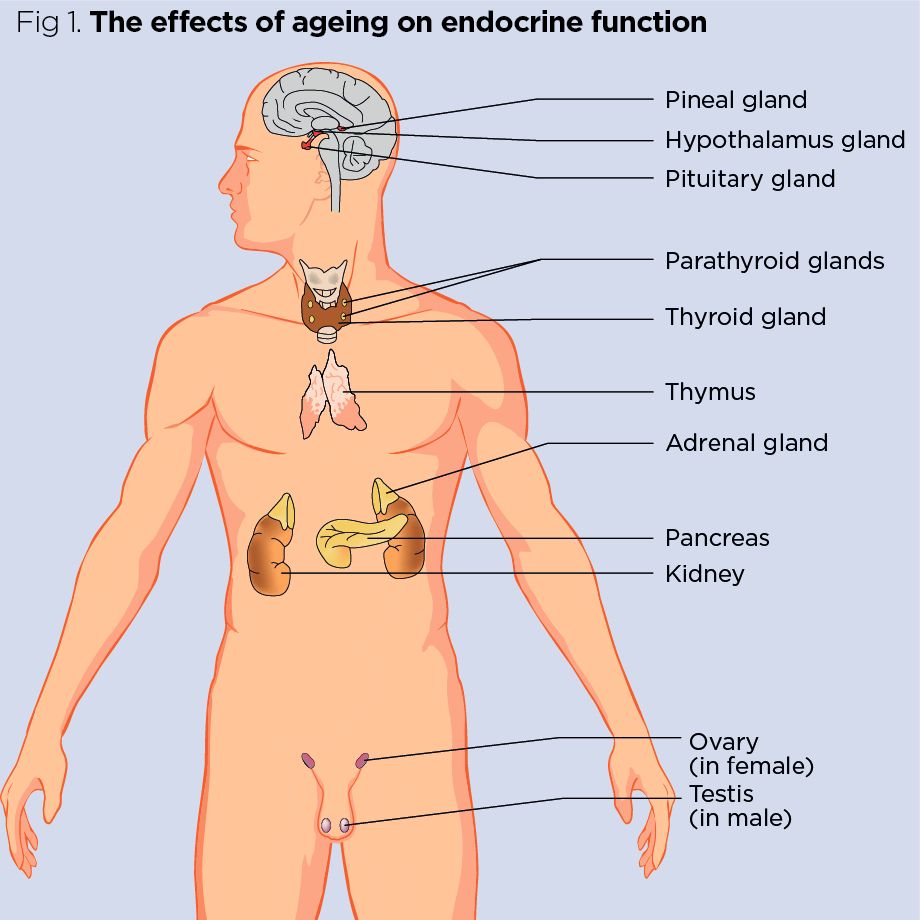 ), thyroid-stimulating cells – thyroid-stimulating hormone (stimulates
), thyroid-stimulating cells – thyroid-stimulating hormone (stimulates
thyroid hormone production), gonadotropic cells – gonadotropic
hormones (have an effect on the sex glands – gonads). Intermediate
The anterior pituitary contains glandular epithelial cells that produce
melanotropin hormone (regulates pigment metabolism).
The posterior lobe of the pituitary developed by protrusion from the diencephalon, consists of
neuroglial cells and is called the neurohypophysis. It secretes two hormones: vasopressin,
or antidiuretic hormone, and oxytocin. These hormones are produced
non-secretory cells of the hypothalamus and along the nerve fibers going from them to
As part of the funnel, they enter the posterior lobe of the pituitary gland, where they accumulate (deposit).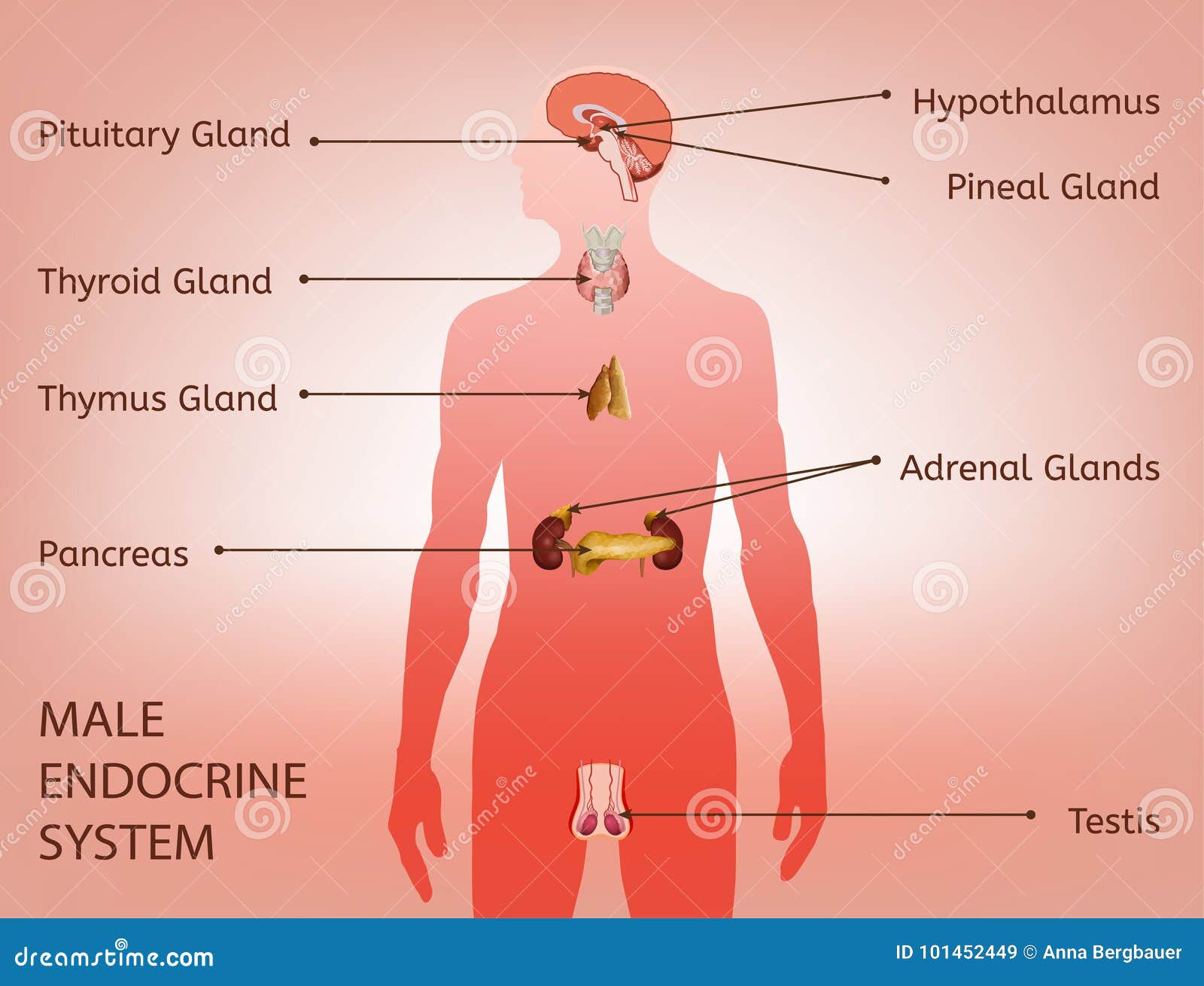
From the posterior lobe, as needed, they enter the bloodstream.
The pineal body (corpus pineale), or the epiphysis of the brain, represents
is a small organ weighing up to 0.25 g, shaped like a fir cone. He
located in the cranial cavity above the plate of the roof of the midbrain in the groove between the two
upper mounds; with the help of the so-called leashes, it is connected with the visual tubercles
diencephalon
The pineal body is covered with a connective tissue sheath from which
trabeculae (transitions), dividing the substance of the gland into small lobules. In slices
there are polygonal-shaped cells called pinealocytes, and neuroglia cells.
The thyroid gland (glandula thyroidea) is the largest of the
endocrine glands, its mass in an adult reaches 30-50g. In the gland, the right
In the gland, the right
and the left lobe and the isthmus connecting them. From the isthmus in some people departs
upward process, called the pyramidal lobe. The gland is located in the anterior
neck and covered with fascia. The lobes of the gland are adjacent to the thyroid cartilage of the larynx and to the cartilages
trachea; the isthmus is located in front of the 2nd-4th tracheal rings. outside iron
has a fibrous capsule, from which partitions extend inward, separating the substance
glands into lobules. In the lobules between the layers of connective tissue are
follicles (vesicles). The walls of the follicles are made up of a single layer of glandular cells.
– thyrocytes. The size (height) of thyrocytes changes in accordance with their
functional state.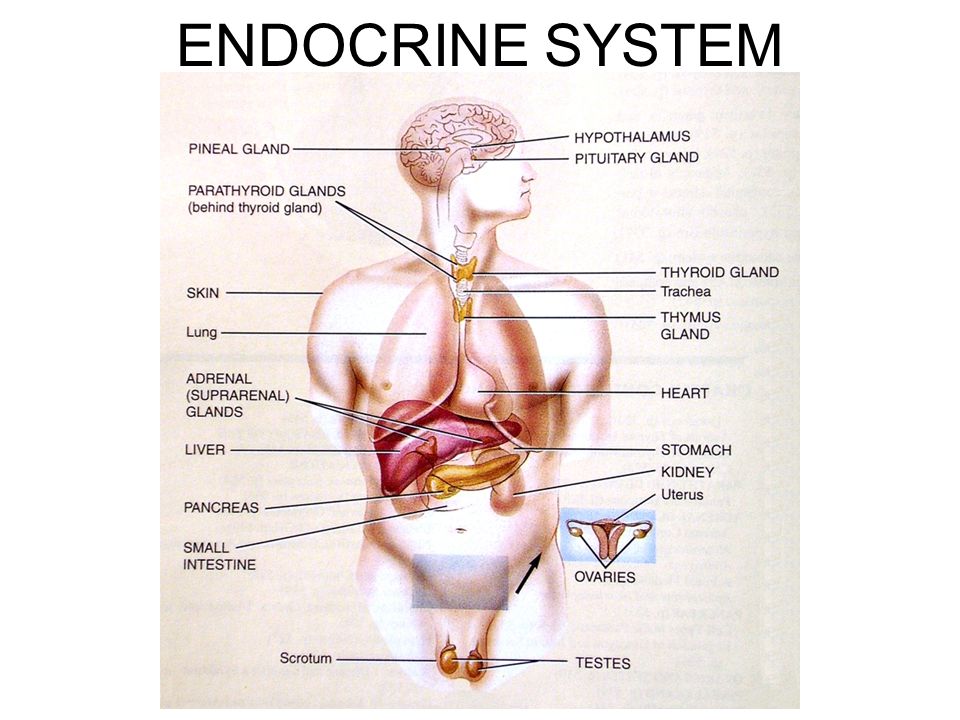 With moderate activity, they have a cubic shape, and
With moderate activity, they have a cubic shape, and
with increased secretory activity, they swell and take the form of prismatic
cells. The cavity of the follicles is filled with a thick substance – a colloid, which
secreted by thyrocytes and contains hormones.
Thyroid hormones – thyroxine and triiodothyronine – influence
on various types of metabolism, as well as on the activity of the nervous system. At
hyperfunction of the gland (excessive secretion of hormones) thyrotoxicosis develops
(Basedow’s disease), with hypofunction – myxedema,
The thyroid gland, parathyroid glands and the thymus are formed from
rudiments of gill pockets (endodermal origin) and together make up
branchiogenic group of glands (branchiae – gills).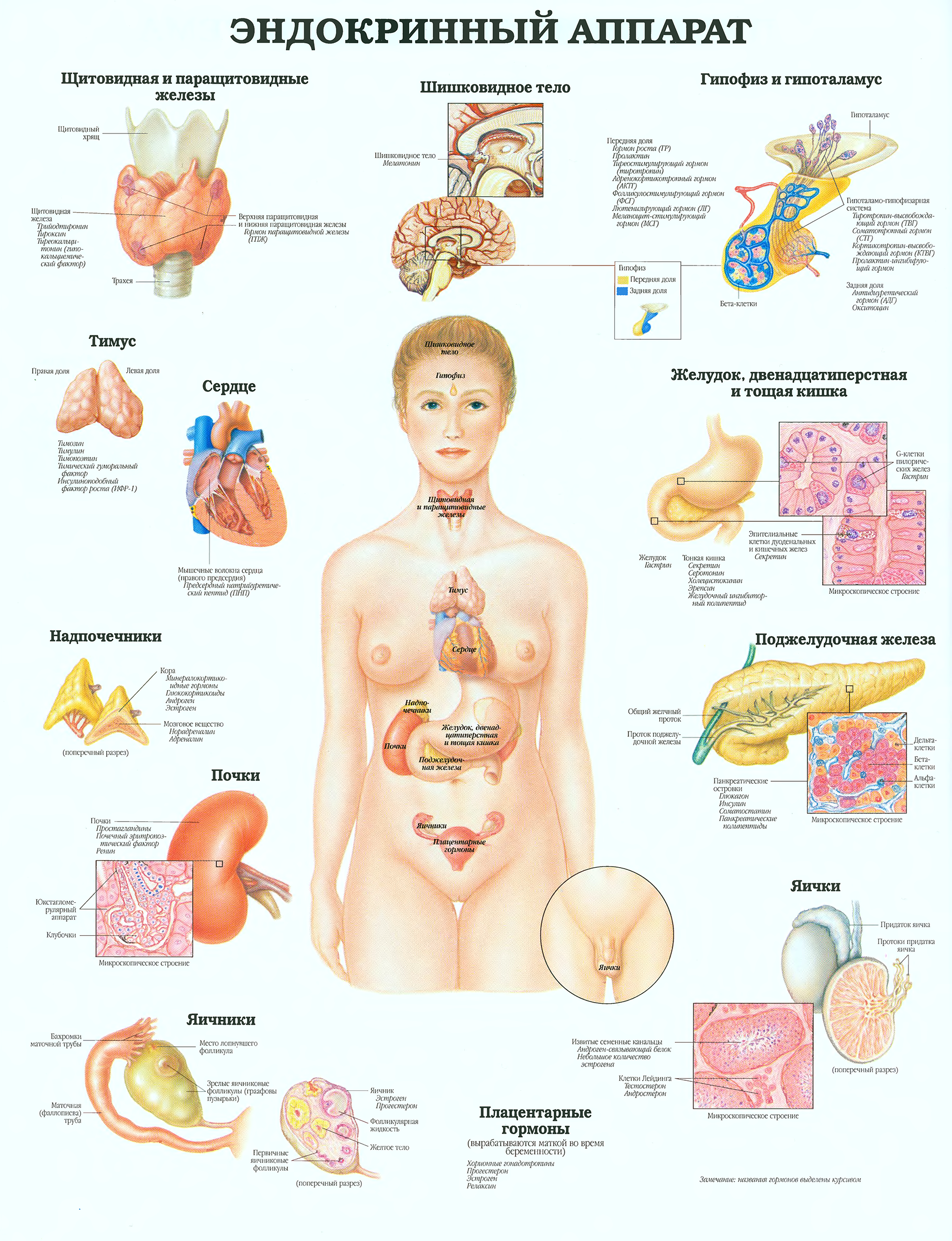
Parathyroid (parathyroid) glands (glandulae parathy-roideae),
two upper and two lower, are small bodies of oval or rounded
forms, each weighing up to 0.09 g. They are located on the back surface of the right and left
lobes of the thyroid gland along its arterial vessels. Connective tissue
the capsule of each gland sends processes inside. between layers of connective tissue
tissue contains glandular cells – parathyrocytes. They secrete a hormone
parathyroid glands parathyrin (parathyroid hormone), which regulates calcium metabolism and
phosphorus in the body.
The thymus, or thymus (thymus), consists of two lobes: the right
and left, connected by loose connective tissue.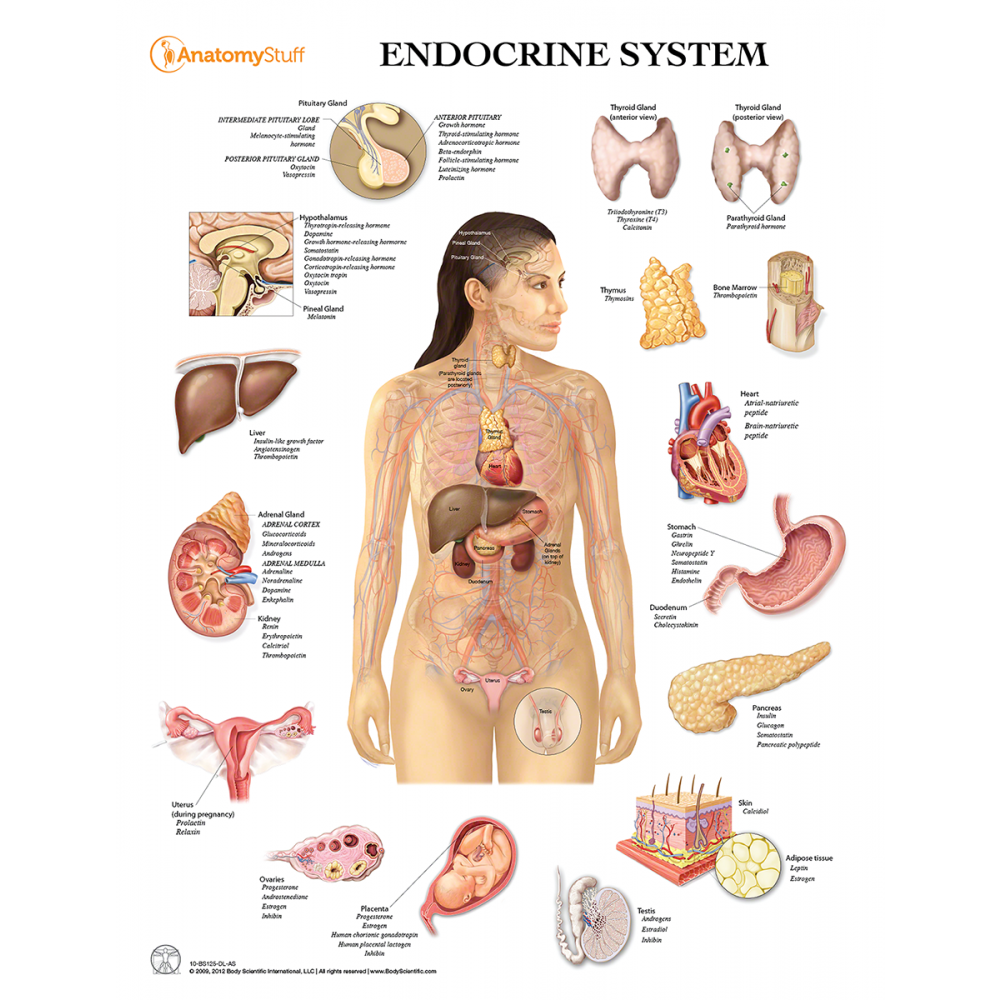 She is at the top
She is at the top
anterior mediastinum, behind the manubrium of the sternum. In children, iron with its upper end
can protrude through the upper opening of the chest into the neck. Mass and
The size of the gland changes with age. In a newborn, the mass of the gland is about 12 g,
increases rapidly in the first two years of a child’s life, the largest value (up to 40 g)
reaches the age of 11-15 years. Age begins at the age of 25
involution of the gland – a gradual decrease in the glandular tissue with its replacement
fatty tissue.
According to the International Anatomical Nomenclature, the thymus belongs to the group of endocrine
glands. At present, the thymus gland is usually referred to as the hematopoietic organs.
and immunological protection. In addition to the thymus, these organs include red bone
brain, lymphatic follicles of the digestive system and other organs,
body lymph nodes and spleen. The thymus gland is called the central organ
immunity; it reproduces immune cells – T-lymphocytes.
The precursors of T-lymphocytes are lymphoblasts – special cells that
entering the thymus from the red bone marrow.
The thymus gland is covered with a connective tissue capsule, from which processes extend,
separating the substance of the gland into lobules. Each lobule is divided into cortical and medullary
substance. The basis of the lobules is arranged in the form of networks of process
epithelial cells, between which there are T-lymphocytes.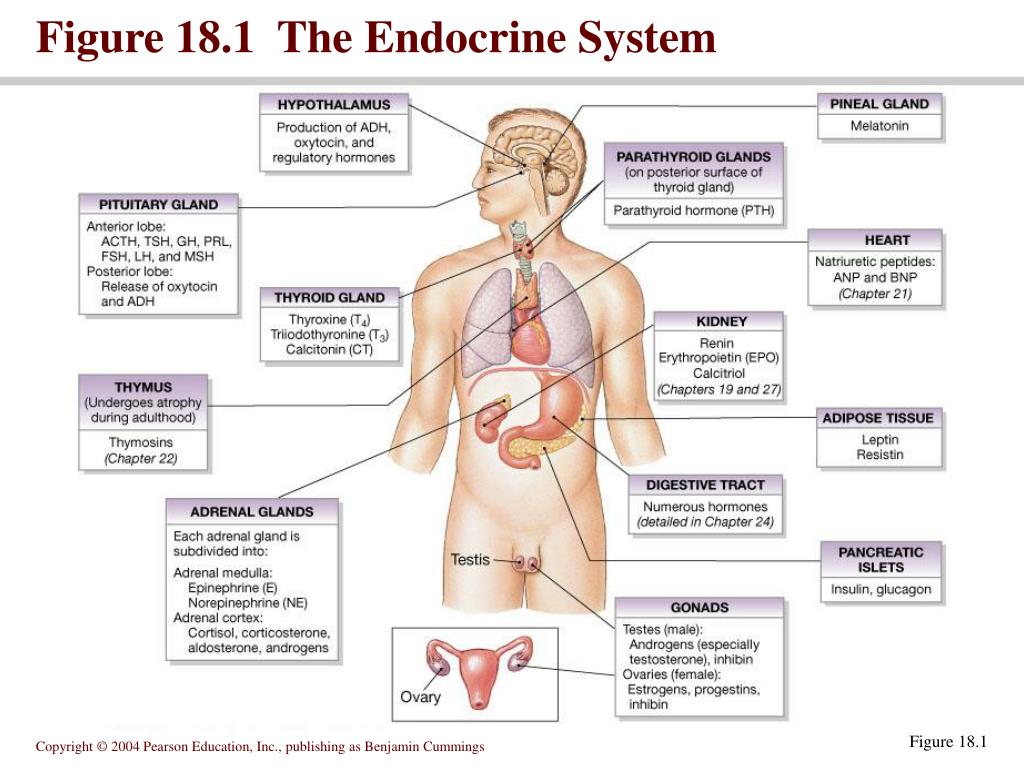 The cortical substance
The cortical substance
compared with the medulla, the gland lobules contain significantly more lymphocytes and
darker color. The cortex also contains lymphoblasts. In the process of them
division, new T-lymphocytes arise. There is a constant transition of T-lymphocytes from
cortical substance into the blood and their migration to the lymph nodes and spleen, where
neither mature into active cells. T-lymphocytes of the medulla
their ultra-microscopic structure and properties are somewhat different from
T-lymphocytes of the cortex; they are not formed in the thymus medulla, but
enter it from the blood. Inside the medulla there are concentric bodies,
or Hassall’s little bodies, consisting of epithelial cells arranged in circular layers.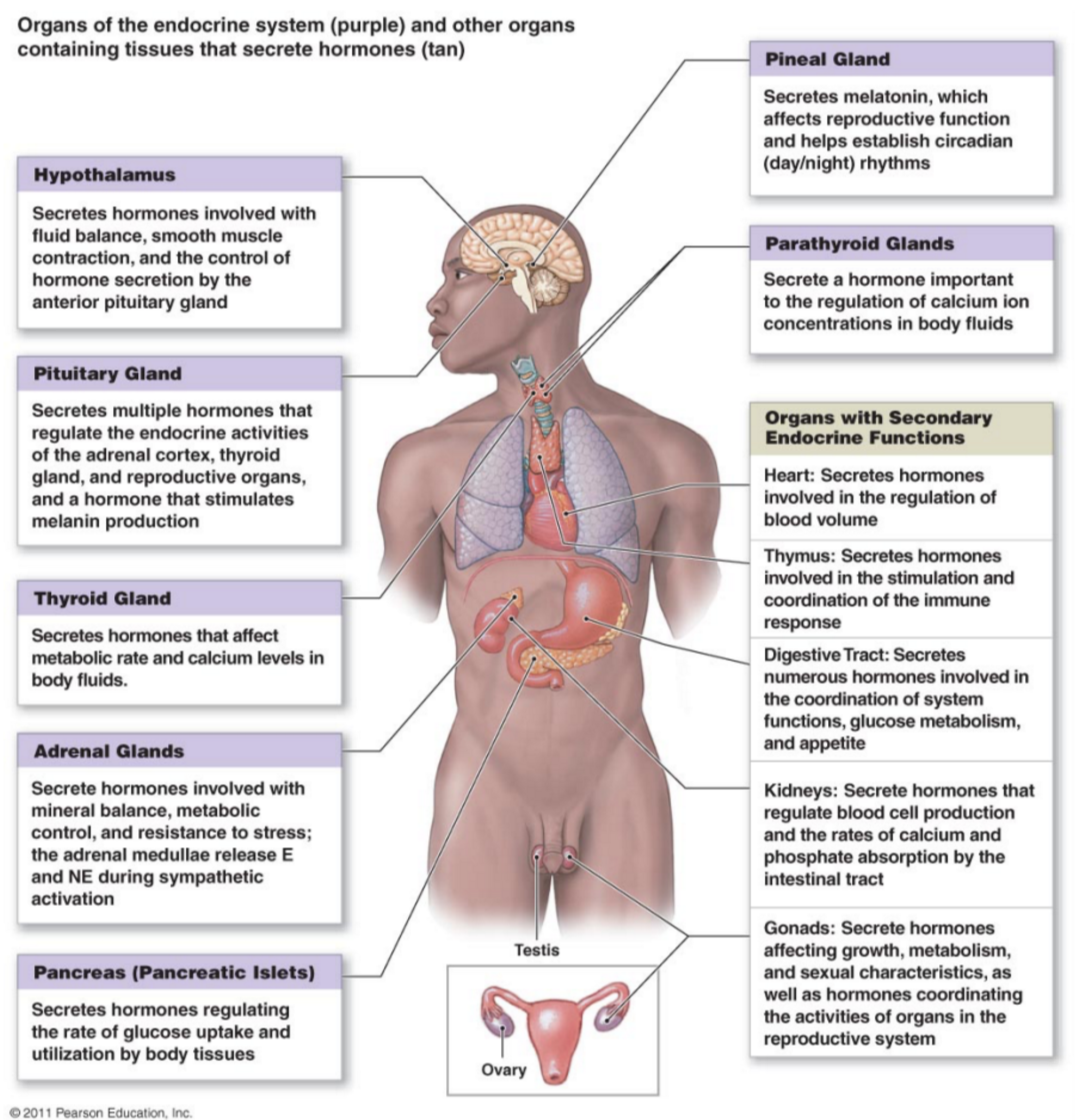
Various biologically active substances have been isolated from the thymus gland, affecting
some body functions, including hematopoiesis (hormone thymosin),
carbohydrate metabolism (insulin-like factor), growth (growth factor), calcium metabolism and
phosphorus, etc. Removal of the thymus in young animals leads to growth retardation, and then
to death.
Adrenal gland, right and left, or the adrenal gland is located in
retroperitoneal space above the upper end of the corresponding kidney. Right
the adrenal gland is triangular in shape, the left one is semi-lunar; the mass of each gland is approx.
10g.
There are two layers in the adrenal gland: the outer yellow layer is the cortical substance (bark) and
the inner brown layer is the medulla. These two layers differ in structure
These two layers differ in structure
and origin, as well as the hormones they secrete and united into one gland in
development process.
The cortical substance is a derivative of the mesoderm, it develops from the same rudiment as
and gonads from the coelomic epithelium It consists of epithelial cells,
between which there are thin layers of loose connective tissue with vessels and
nerve fibres. Depending on the structure and location of epithelial cells in
three zones are distinguished in the adrenal cortex: the outer to l at the barrel, the middle beam and
inner mesh.
Mineralocorticoid hormones are produced in the zona glomeruli of the adrenal cortex
(aldosterone, etc., affect the water-salt metabolism in the body) in the beam zone—
glucocorticoids (involved in the regulation of carbohydrate, protein and fat metabolism) and in
reticulate – sex hormones (androgens and estrogens, have an effect,
similar to sex hormones). Normal sex hormones of the adrenal cortex
Normal sex hormones of the adrenal cortex
are produced mainly in childhood, when the intrasecretory function
ovaries (or testicles) is not yet expressed.
The adrenal medulla is derived from the ectoderm and develops from the same
rudiment, as the nodes of the sympathetic trunks. It is made up of glandular cells.
called chromaffin. Adrenal medulla hormones
epinephrine and norepinephrine (catecholamines, affect various functions
organism, similar to the influence of the sympathetic division of the autonomic nervous system).
Accumulations of chromaffin cells, in addition to the adrenal medulla, are found in
called paraganglia – small bodies located in some places
body, for example, at the division of the common carotid artery into internal and external (carotid
glomus – tangle), near the abdominal aorta (lumbar aortic paraganglion).![]()
Security questions:
- What glands are called endocrine glands? 2. What do the terms mean
“endocrine” and “hormone”? 3. List the endocrine
glands. 4. Location of each endocrine gland. 5. Key features
structure of the endocrine glands. 6. What is the leading role of the anterior lobe
pituitary in the endocrine system? 7. Pituitary gland; position, weight. 8. Shares
pituitary gland: name, from what developed? 9. Pineal body: position, mass,
Latin name. 10. Thyroid gland: position, mass, Latin name.
11. Parathyroid glands: position, quantity, name of the hormone of these glands.
12. Thymus gland: position, shares, Latin name. 13.


